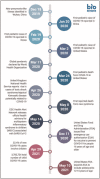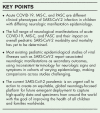Worldwide epidemiology of neuro-coronavirus disease in children: lessons for the next pandemic
- PMID: 34654049
- PMCID: PMC8571058
- DOI: 10.1097/MOP.0000000000001069
Worldwide epidemiology of neuro-coronavirus disease in children: lessons for the next pandemic
Abstract
Purpose of review: The severe acute respiratory syndrome coronavirus-2 (SARS-CoV-2) pandemic has overwhelmed the global community, negatively impacting patient health and research efforts; associated neurological manifestations are a significant cause of morbidity. This review outlines the worldwide epidemiology of neurologic manifestations of different SARS-CoV-2 clinical pediatric phenotypes, including acute coronavirus disease 2019 (COVID-19), multisystem inflammatory syndrome in children (MIS-C) and postacute sequelae of COVID-19 (PASC). We discuss strategies to develop adaptive global research platforms for future investigation into emerging pediatric neurologic conditions.
Recent findings: Multicenter, multinational studies show that neurological manifestations of acute COVID-19, such as smell/taste disorders, headache, and stroke, are common in hospitalized adults (82%) and children (22%), associated with increased mortality in adults. Neurological manifestations of MIS-C are reported in up to 20% of children, including headache, irritability, and encephalopathy. Data on PASC are emerging and include fatigue, cognitive changes, and headache. Reports of neurological manifestations in each phenotype are limited by lack of pediatric-informed case definitions, common data elements, and resources.
Summary: Coordinated, well resourced, multinational investigation into SARS-CoV-2-related neurological manifestations in children is critical to rapid identification of global and region-specific risk factors, and developing treatment and mitigation strategies for the current pandemic and future health neurologic emergencies.
Copyright © 2021 Wolters Kluwer Health, Inc. All rights reserved.
Conflict of interest statement
Figures



References
-
- Carod-Artal FJ. Neurological complications of Zika virus infection. Expert Rev Anti Infect Ther 2018; 16:399–410. - PubMed
-
- WHO. WHO Coronavirus (COVID-19) Dashboard [Internet]. Geneva: World Health Organization; 2020 [cited July 12, 2021]. Available from: https://covid19.who.int.
-
This website is continually updated to demostrate the global epidemiological impact of SARS-CoV-2.
Publication types
MeSH terms
Supplementary concepts
Grants and funding
LinkOut - more resources
Full Text Sources
Medical
Research Materials
Miscellaneous

